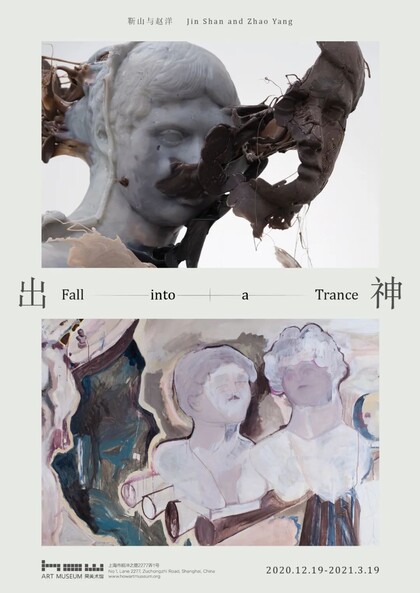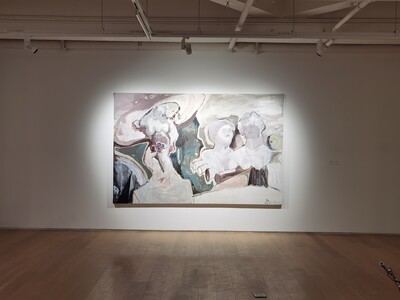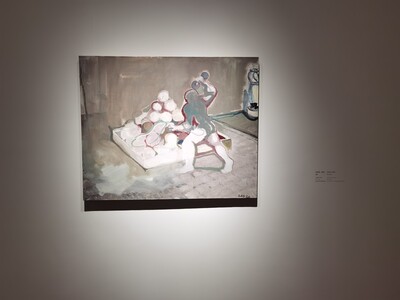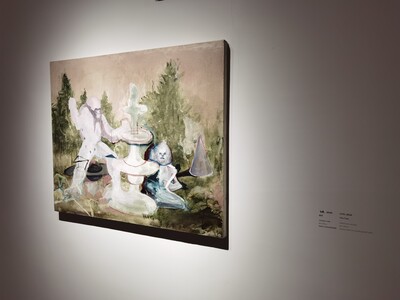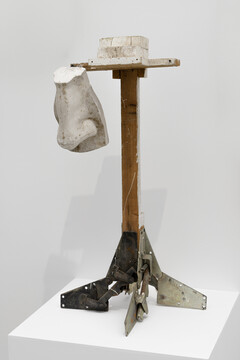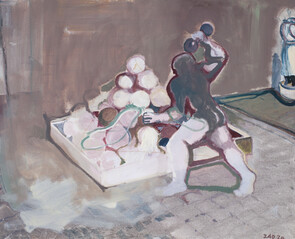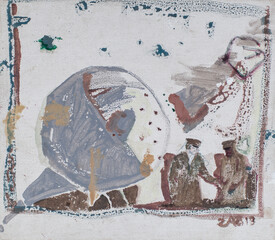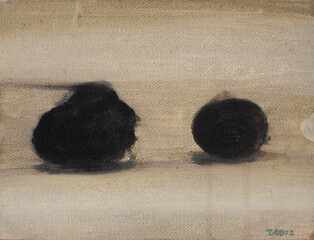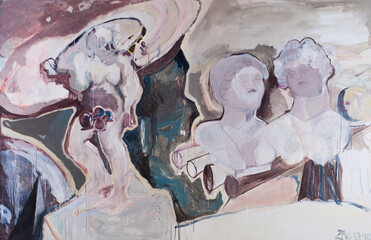Group Exhibition How Art Museum, Shanghai
At the moment it seems there’s nothing better to do than “falling into a trance”.
“Speed is a form of ecstasy.” In Slowness, a motorcyclist who is eager to overtake “is caught in a fragment of time cut off from both the past and the future; he is wrenched from the continuity of time; he is ousted time; in other words, he is in a state of ecstasy…”[1]
In the state of “trance” (or “ecstasy”[2]), man gains access to experiencing two different states of consciousness at the same time: the absorption in the oblivion of self-existence and the “dissociation” [3] of escaping from the now and here. The seemingly ambiguity bestows “trance” the freedom to wander between “in” and “out”, a privilege to get around and even resist linear time.
To Jin Shan and Zhao Yang, the turbulent 2020 marked a timing for them to “fall into a trance”. Jin Shan moved his studio to a place closer to downtown Shanghai in the end of summer. And Zhao Yang made an even longer-distance move after the Spring Festival – he moved from Beijing back to Hangzhou, the place he left over a decade ago.
The dual exhibition at HOW Art Museum Shanghai features a spontaneous state of “trance” the two artists presented during a time of changes. Works on show are mostly recent works by Jin Shan and Zhao Yang and encompass a mix of media including painting, sculpture and installation. Within the non-linear intersections developed by time-space construction and self-expression, the two artists resorted to different (images of) bodies in the attempt to explore for a unique spiritual path of cultural modeling and new possibilities to envisage the uncertain.
Compared with the sharp and outwardly torn-apart world in Jin Shan’s work, images presented by Zhao Yang show a sense of inward collapse. As a trained painter, Zhao Yang’s practice on canvas tends to conceal ingenuity beneath the seemingly plainness and reveal a sense of loop from “nothingness” to “somethingness” and then back to “nothingness”.[4] During the process of painting, Zhao Yang attempted to conceal, shied and even destroy the narratives constructed in the drafts, creating a sense of paradox wandering between reality and dream. The beauty of Zhao Yang’s work lied in the deviations and difference between the actual work and the initial ideas. Lines and traces sliding on the canvas were constantly wiped and smeared by the artist, imbuing ambiguity and vagueness into the previously recognizable objects and familiar scenarios and making them further integrated during the constant re-painting. Thanks to that the imagery that was once confined to classical visual ideographical system gradually ground its way out of the figural system, entering a state described by Zhao Yang as “a lonely babbler or semi-lingual talker”, which in essence was a state of “trance” that could hardly be confined or captured. The journey to clear away the mist and search for the destination within artwork extended along with the flow of babbling.
Sometimes it takes Zhao Yang a couple of years to complete a piece of work. Only Similarity Is Ours (2009-2013), an oil on printed canvas, was one of those works and was intricately related with the decision for Zhao Yang to become a professional artist. In 2010, after fifteen years working as an editor in Hangzhou, he quitted. It was more an urge to embrace the rough reality, potential hindrance and the capital city of the country than a merely premeditated getaway. The daily confrontation with difficulties was embodied in his artistic practice. While working on Only Similarity Is Ours, Zhao Yang ingeniously chose to print the image onto the canvas in advance. It could become a kind of obstruction, in a sense. And the process of using acrylic to cover and re-paint was like “to come round the stumbling block and open up a strange space”.[5] The somewhat chaotic world of images was a way for the artist to connect with the outside world, and he invited the audience to enter into his spiritual world to share the amazement and turmoil he felt. The plaster heads (of human figures and animals) scattered in the work appeared in pair with facial profiles, demonstrating a kind of “hybrid” – the image of monsters in the artist’s mind as a result of the inspirations gained from mythologies and fables both from the east and the west. In 2013, Zhao Yang wrote down “only similarity is ours” at the bottom right corner of the painting as a mark for the completion of the work.
His latest work Cepheus (2019-2020) derived from Only Similarity Is Ours. Behind the bodies trapped in nebula, the head statue in pairs and the geometrical figures, time and space were folded and collaged within the immense universe. In the past two years, Zhao Yang was highly interested in the topics of hidden stars. And in the meantime, the sense of desolation still hovered as the background of his work. Since the emergence of factory-like architectures in his work in 2008, desolate “ruins” constantly appeared in Zhao Yang’s art in a solemn and yet flexible manner. The utopia of industrial civilization (Ubiquitous, 2009), the natural wasteland in the forest of memory (Hunting Series, 2014-) and the overwhelming infinity hovering on top of human beings (Star Image Series, 2019- ) were all examples of that. Zhao Yang’s art had been disengaged from the hustle and bustle of the outside world. Pure velocity was no longer visible, replaced by temporary stagnation and disoriented wandering; in other words, a state of leisurely “trance”.
Anthropoid (2020), Striker (2020) and UFO (2020), three pieces that consisted a painting triptych of Zhao Yang, were interconnected like montage in the movie and in the meantime went on with their own paths. In the name of Volcano (2019) by Jin Shan, the lit candle on the purplish black palm shed light till the very end of its life, leaving imprints on the raised knuckles and the torso that was confined by chains and sinking in Island (2020)...
The smoke left by the candlelight that died out, like a long pause in Zhao Yang’s conversation, gives a moment for a breath. It is also like the glow of the setting sun reflected through the windows of Jin Shan’s studio.
Fall into a trance, for once.
More Pictures:

